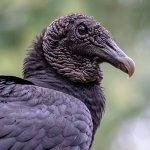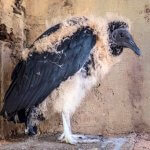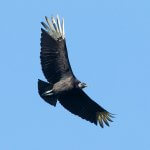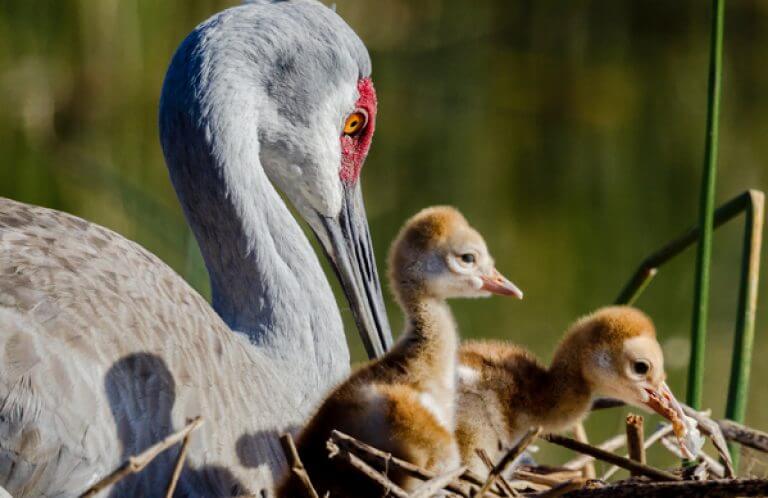About the Black Vulture
In this species account, we highlight the Black Vulture found throughout the Americas, not the Black, or Cinereous, Vulture (Aegypius monachus), a different species native to Europe and Asia. “Our” Black Vulture is also known as the American Black Vulture and Mexican Vulture, and in other languages, by names such as Zopilote (thief), Urubu, or Gallinazo (buzzard, vulture).
The American Black Vulture can be identified by its all-black plumage, light gray legs, and a bald, grayish-black head and neck. The featherless head, a feature it has in common with other scavenging species such as the California and Andean Condors, is a practical adaptation to its sometimes-messy diet of carrion and refuse.
The Black Vulture is often found in the same areas as its larger relative, the Turkey Vulture.
Black or Turkey?
Seen perched, the Black Vulture is smaller than the Turkey Vulture, and has a grayish-black, rather than a red, bare head, and a noticeably shorter tail. In flight, the differences between the two species become more obvious, even from a distance.
Seen from below, the Black Vulture's light-colored flight feathers appear as pale wing patches, in contrast with the Turkey Vulture's two-toned underwings. The Black Vulture's hurried-looking flight style — quick, snappy wingbeats interspersed with short glides – is quite different from the Turkey Vulture's longer, more leisurely-looking glides. The Black Vulture's flight profile appears relatively flat, while the Turkey Vulture rocks from side to side as it soars, with its wings held in a characteristic V shape.
Songs and Sounds
Like other vultures, the Black Vulture lacks a syrinx, or vocal organ, so the only sounds it can make are bark-like grunts and hisses, which can be heard during aggressive encounters or when a bird feels threatened.
Listen here:
Breeding and Feeding
Vulture Culture
The Black Vulture is a social species, foraging, roosting, and even courting in groups. Males will form a small group while courting a female, walking around her with wings partly spread and heads rapidly bobbing. Individual pairs also may engage in courtship flights, and, like the Sandhill Crane or Laysan Albatross, engage in ritualized dances where a pair faces each other with upheld wings, alternately jumping in the air while vocalizing.

Black Vulture pairs are monogamous and remain together for life. A pair does not build a nest, but rather chooses a cave, cliff crevice, hollow tree, or vacant building as a nest site, where the female lays a clutch of two eggs on the ground. The pair takes turns incubating their eggs for roughly a month. When the young hatch, they are covered with a coat of thick, light-colored down. The parents feed their young through regurgitation. The vulture nestlings are slow-growing, not fledging for approximately two and half months. They stay close to their parents even after leaving the nest and continue to be fed by them long after they have fledged.
This social species forms kinship groups comprised of close and extended relatives that maintain long-term relationships, remaining in close contact throughout the year. This level of cooperation gives individuals a competitive edge at crowded roosts and around carcasses.
Down in the Dumps
Like its relatives, the Black Vulture is chiefly a scavenger, seeking carrion at garbage dumps, landfills, slaughterhouses, and roadsides. This species sometimes preys on weak, sick, or newborn animals if the opportunity presents itself, a habit that sometimes leads to conflict with people.
Unlike the Turkey Vulture, which detects carrion with its keen sense of smell, the Black Vulture hunts by sight. It often follows Turkey Vultures to find food and is notably aggressive once at a carcass or other food source, driving away larger vultures and other scavengers.
Region and Range

The Black Vulture is mainly a permanent resident throughout its range, occurring from the central and southern United States, through Mexico, Central America, and most of South America. Birds at the northern extent of its range may migrate short distances. The species is able to take advantage of human-altered landscapes and is expanding its range northwards.
Conservation

Help support ABC's conservation mission!
Although Black Vulture numbers are increasing, this species still faces challenges in human-altered landscapes. Available nest sites are often scarce, and these birds will abandon existing nest and roosting sites in the face of human pressures. This species is a frequent victim of collisions with military and passenger planes.
Although protected by the Migratory Bird Treaty Act of 1918 and other treaties, this vulture is often persecuted and even illegally killed by ranchers and property owners, who believe that its large roosts spread disease and depredate newborn livestock, although these fears are largely unwarranted. In the main, Black Vultures and other avian scavengers provide valuable natural cleaning services and are an essential part of any ecosystem.
Get Involved
Policies enacted by the U.S. Congress and federal agencies, such as the U.S. Fish and Wildlife Service, have a huge impact on U.S. birds. You can help shape these rules for the better by telling lawmakers to prioritize birds, bird habitat, and bird-friendly measures. To get started, visit ABC's Action Center.
Living a bird-friendly life can have an immediate impact on the birds around you. Doing so can be as easy as adding native plants to your garden, avoiding pesticides, and keeping cats indoors. To learn more, visit our Bird-Friendly Life page.
American Bird Conservancy and our Migratory Bird Joint Venture partners have improved conservation management on more than 8.5 million acres of U.S. bird habitat — an area larger than the state of Maryland — over the last ten years. This is a monumental undertaking, requiring the support of many, and you can help by making a gift today.























































